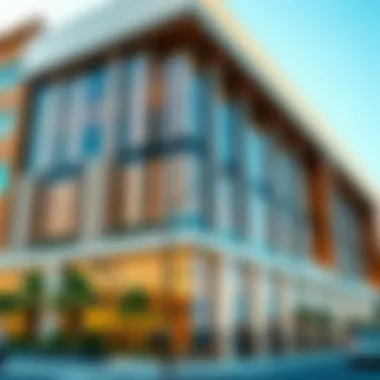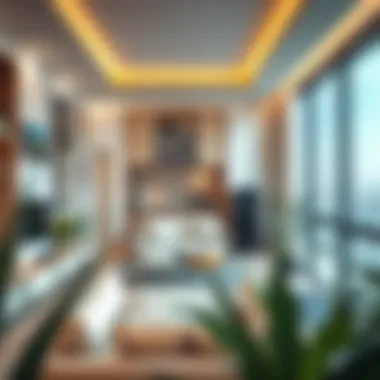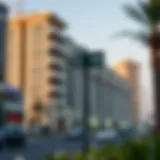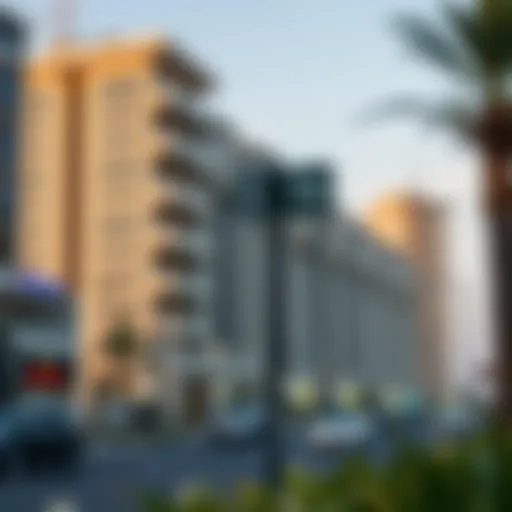Liwa Building Mankhool: Architecture and Investment Insights


Intro
The Liwa Building in Mankhool is more than just another structure in the bustling heart of Dubai; it's a testament to modern architectural prowess and an illustration of the shifting sands of the real estate market in this vibrant city. Nestled amid a myriad of amenities, it stands tall, drawing attention not only for its aesthetic value but also for the investment opportunities it presents in the ever-evolving property landscape. In this analysis, we’ll explore several crucial aspects concerning the Liwa Building, focusing on its architectural significance, residential offerings, investment potential, and the broader implications for Dubai’s real estate market.
Dubai's real estate scene is as dynamic as the shifting dunes around it, making it essential for potential investors, buyers, and industry professionals to stay informed. Let's embark on this thorough examination to reveal what makes the Liwa Building a noteworthy consideration for anyone serious about making a mark in the property sector.
Market Insights
Current Trends in Dubai Real Estate
Dubai’s real estate market has shown resilience and adaptability over the years. Post-pandemic recovery, driven by a surge in demand from expatriates and foreign investors, is reshaping the landscape. The recent trend leans towards residential properties that offer a blend of luxury and practicality. Mankhool, in particular, is basking in the spotlight, drawing considerable attention due to its strategic location and the influx of developments.
- Off-plan investments are gaining traction, as developers roll out projects that are aesthetically appealing yet financially viable.
- Sustainable living is becoming a significant demand, with green buildings starting to take center stage—the Liwa Building exemplifies these shifts, boasting amenities that cater to a modern lifestyle.
Economic Factors Impacting Property Values
Understanding the economic undercurrents is crucial for grasping the volatility in property values. Several factors currently play a pivotal role:
- Interest rates are on a gradual rise, leading to an increased caution among buyers and investors. This could either stabilize prices or lead to a market correction in the near future.
- Inflation rates are influencing purchasing power. Higher living costs tend to dampen demand; however, the luxury segment often remains less affected.
- Government policies, such as relaxed visa restrictions and enhanced ownership laws for expatriates, are also key contributors.
"Staying updated on the market trends and economic landscape is crucial for anyone contemplating investment in Dubai's diverse property offerings."
Investment Guides
Tips for First-Time Buyers
For those keen on making a first investment in the Liwa Building or similar properties, here are some practical tips:
- Research thoroughly: Understand the neighborhood, the building's history, and its future potential.
- Consult with local experts: Collaborate with real estate agents who have in-depth knowledge of Mankhool and its surroundings.
- Assess your budget: Be clear about your financial standing and remember to factor in additional costs such as maintenance fees and taxes.
Portfolio Diversification Strategies
Investors looking to diversify their portfolios can consider several strategies:
- Mix property types: Consider a combination of residential properties within the Liwa Building with commercial units elsewhere in Dubai.
- Explore off-plan properties: A popular strategy to take advantage of lower prices and potential future gains.
- Invest in emerging areas: Look for upcoming neighborhoods that may not yet be on everyone's radar but show promise for growth.
The Liwa Building, with its unique offerings, stands at the crossroads of opportunity in Dubai's extensive real estate ecosystem.
For further insights and resources, visit Dubai Land Department or read more about real estate strategies on platforms like Reddit.
In the following sections, we will dive deeper into the architectural elegance of the Liwa Building and the unique amenities it promises to its residents.
Preface to Liwa Building
The Liwa Building stands as a significant landmark in the bustling district of Mankhool, Dubai. Understanding its role and influence sheds light on the broader real estate landscape within this dynamic city. This section aims to dissect the importance of the Liwa Building, focusing on its historical backdrop, architectural essence, and how it fits into the urban fabric of Mankhool.
Historical Context of Mankhool
Mankhool is a neighborhood imbued with rich history and cultural significance, tracing back to the early days of Dubai's development. The area was once a hub for trade and commerce, flourishing alongside the growth of the city. Today, Mankhool reflects a blend of traditional Emirati culture and modern influences, positioning Liwa Building at the crossroads of past and present. The evolution of Mankhool from a simple village to a major urban district has created a vibrant atmosphere, attracting a diverse population eager to partake in its prosperity, which in turn enhances the appeal of residential and commercial properties like Liwa Building.
Overview of Liwa Building
At first glance, Liwa Building captivates with its innovative architecture designed to harmonize with the surrounding environment. Rising to multiple floors, this structure houses residential units, offering a blend of modernity and practicality. With its sleek lines and strategic use of space, it showcases contemporary design principles while also addressing the need for functionality in urban living. Prospective investors and residents often gravitate towards this building due to its appealing features—everything from resident amenities to unobstructed views of the cityscape. This building captures the essence of what modern living should look like.
Purpose and Significance
The Liwa Building serves several pivotal roles in the real estate market of Mankhool. Primarily, it fulfills the growing demand for quality housing amidst rapid population growth in Dubai. The design and strategic location of Liwa Building not only cater to residents seeking comfort but are also attractive to investors looking for properties with promising returns. Its integration into the community contributes significantly to urban life, creating a sense of place that exceeds mere bricks and mortar. Moreover, the building serves as a case study in sustainable development, showcasing how modern architecture can work in harmony with the environment.
In summary, the Liwa Building is not just a structure but a vital part of Mankhool’s identity and growth story. As various facets of the residential and commercial landscape evolve here, understanding the role of such buildings becomes essential for anyone involved in Dubai’s real estate realm.
Architectural Features
When analyzing a structure like Liwa Building in Mankhool, the architectural features serve as a lens through which its significance and functionality can be explored. These elements not only embody the aesthetic appeal of the building but also enhance its utility and sustainability.
Design Elements
The design elements of the Liwa Building reflect a thoughtful combination of form and function. The facade proudly showcases a modern aesthetic, embodying clean lines and a harmonious blend of colors that catch the eye without overwhelming the senses. Glass panels elegantly contrast with solid structures, allowing natural light to flood the interior while offering a glimpse of the urban landscape beyond.


In addition to aesthetic considerations, the layout is carefully crafted to optimize space. For instance, balconies and terraces extend the living space outdoors, encouraging residents to enjoy the fresh air while taking in the sights of Mankhool. Architecturally, the building is a response to both the climate of Dubai and the lifestyle of its inhabitants, promoting outdoor living through shade and ventilation.
Materials and Sustainability
Materials used in the construction of the Liwa Building were selected for both durability and environmental considerations. Using high-quality concrete and glass not only ensures longevity but also reflects a commitment to sustainability. For instance, the incorporation of environmentally-friendly materials, such as recycled steel and energy-efficient glass, reduces the building's carbon footprint significantly.
Moreover, energy-efficient features, including advanced insulation and solar panels, allow for reduced energy consumption—an attractive proposition for environmentally-conscious investors. Also, the maximization of natural light along with effective water management systems means lower maintenance costs and enhanced overall sustainability. Such choices illustrate a growing trend within Dubai’s real estate market, where property developers are increasingly expected to lean into green building practices.
Interior Layout and Amenities
Inside the Liwa Building, the interior layout is designed to create a sense of community while providing individual comfort. Units range from compact studios to larger multi-bedroom apartments, catering to diverse demographics. Open-concept living spaces promote an expansive feel, while strategically placed walls offer privacy without sacrificing natural light.
The building also boasts modern amenities that enhance residents' quality of life. Features such as a fitness center, communal lounge areas, and landscaped gardens encourage social interactions, making the building more than just a place to live. This design philosophy speaks to a trend in urban development where the emphasis is placed on creating lifestyle-oriented environments rather than mere residential structures.
"A well-designed building doesn't just serve a function but creates a lifestyle."
With these architectural features, Liwa Building stands out as a prime example of contemporary urban living; its design elements, commitment to sustainability, and thoughtful interiors contribute to its desirability in the bustling area of Mankhool. As both investors and residents look for properties that offer comfort, functionality, and aesthetic appeal, Liwa Building checks all the right boxes.
Residential Offerings
The section on Residential Offerings is pivotal in understanding the Liwa Building’s role in Mankhool, as it sheds light on the range and types of residences available. This analysis of living spaces is crucial, not just for potential residents, but for investors and developers exploring the shifting dynamics of the real estate market in Dubai. With a keen demographic focus, the insights provided here will help identify who resides in these units, their lifestyle preferences, and the financial commitments involved.
Types of Units Available
Liwa Building features an assortment of residential units that cater to various preferences and budgets. The design caters to both singles seeking contemporary living and families looking for spacious dwellings. Key unit types include:
- Studios: Ideal for young professionals, these compact units offer an efficient use of space, maximizing livability without compromising comfort.
- One-bedroom apartments: These units are perfect for couples or individuals desiring a touch more privacy. Equipped with modern amenities, they often come with balconies that embrace the views of Mankhool.
- Two-bedroom apartments: These are sought after by small families. With ample room, they accommodate communal living while ensuring personal spaces.
- Larger family units: Some exclusive tiers cater to bigger families, featuring multiple bedrooms and expansive living areas, complete with modern kitchen facilities.
Understanding the types of units available at Liwa Building allows prospective buyers or renters to match their housing needs with available options effectively. The diversity ensures there’s something for everyone, and that accommodates the neighborhood’s varied demographic.
Target Demographic and Lifestyle
The target demographic of the Liwa Building mirrors the vibrant lifestyle of Mankhool. Many residents are expatriates, including professionals and young families, drawn to the area due to its convenience and community feel.
- Young Professionals: Many individuals in their 20s and 30s flock to the studios and one-bedroom units. Their typical need for accessibility to business hubs and entertainment centers aligns with what the Liwa Building offers.
- Families: The larger units attract families who appreciate proximity to schools and parks. The neighborhood has seen a rise in young families who value community living, making Liwa Building an appealing choice.
- Investors: With a growing rental market, investors are keenly interested in properties that promise high returns, making the diverse residential offerings particularly attractive for investment purposes.
This blend of residents ensures a dynamic community atmosphere within the Liwa Building, with social and recreational activities catering to all demographics.
Rental and Purchase Prices
When it comes to Rental and Purchase Prices, Liwa Building maintains a competitive stance in the Mankhool real estate market. The price range varies significantly depending on unit size and amenities.
- Studios: Rents can typically start from AED 40,000 per year, making them accessible for singles and young couples.
- One-bedroom apartments: Prices for these units usually range from AED 60,000 to AED 80,000 annually.
- Two-bedroom apartments: These are generally available for AED 90,000 to AED 120,000, reflecting their family-friendly amenities and space.
- Purchase Prices: For those looking to buy, studio apartments may go for around AED 600,000, while two-bedroom options can escalate to AED 1.5 million, depending on floor and view.
Understanding these financial elements is vital for potential investors and residents. It helps them place their options within their budget while gauging the potential return on investment for landlords.
"Investing in residential properties at Liwa Building is not just about purchasing a unit; it's about securing a lifestyle in one of Dubai's most vibrant neighborhoods".
In summary, the Residential Offerings at Liwa Building encompass a broad spectrum ranging from compact studios to sprawling family apartments. This variety caters to a compelling demographic, ensuring prospective residents can find a home that fits their needs while also presenting lucrative options for investors seeking meaningful returns.
Location Advantages
In the ever-evolving landscape of Dubai, particularly within the vibrant community of Mankhool, the Liwa Building stands out not just for its striking architecture, but also for the varied advantages its location offers. In real estate, it's often said that the three golden rules are location, location, and location. This phrase could not be more applicable when discussing Liwa Building, as the surrounding area significantly enhances its desirability. From its proximity to major transport routes to the availability of essential amenities, every aspect contributes to making this building a hot item in the real estate market.
Accessibility and Transportation
Accessibility is crucial not only for residents but also for potential investors and businesses looking to tap into the rich demographic that Mankhool attracts. Located near major thoroughfares, Liwa Building offers quick connections to various parts of Dubai. The Al Karama and Al Mankhool Road are just a stone's throw away, allowing for smooth commutes. Moreover, the proximity to the Dubai Metro network provides residents a hassle-free way to navigate the city. The nearest metro station, which is only a few minutes' walk away, serves as a gateway to other critical areas such as Downtown Dubai and the Dubai International Airport.
For those who prefer driving, the roads in and around Mankhool are well-maintained and efficiently managed, ensuring minimal traffic congestion during peak hours. Parking facilities around the Liwa Building are generous, making it appealing for both residents and visitors. Public transport options, including buses and taxis, are abundant, adding to the convenience of living in this prime location.
Proximity to Essential Amenities
Living in Mankhool means having a variety of essential amenities at your fingertips. Ensuring that daily needs are met without inconvenience plays a vital role in a resident's quality of life. Liwa Building, being at the heart of Mankhool, offers easy access to grocery stores, pharmacies, banks, and international schools, making it suitable for families as well as young professionals.
Additionally, popular shopping malls like the BurJuman Centre are a short drive away, allowing residents to indulge in retail therapy or savor culinary delights. For health-conscious individuals, several reputable hospitals and medical centers are located within a 10-minute radius, ensuring that healthcare access is never an afterthought. A list of essentials that are located close by includes:
- Grocery stores such as Star Supermarket and Carrefour
- Medical facilities like Aster Clinic and Burjeel Hospital
- Educational institutions including St. Mary’s Catholic High School
- Recreational parks and community centers for leisure activities


In essence, the abundance of nearby facilities simplifies everyday life, making the Liwa Building an attractive option for those who value convenience.
Neighborhood Characteristics
Beyond mere conveniences, the neighborhood characteristics of Mankhool give a unique charm to the living experience at Liwa Building. Known for its multicultural vibe, Mankhool is home to diverse communities, fostering a rich cultural environment. This mix encourages social interaction among residents and contributes significantly to community bonding.
The area is predominantly residential, yet it also possesses a variety of small businesses and eateries that add character to daily life. Whether it’s enjoying a casual meal at local restaurants or savoring street food, residents have plenty of options to choose from without venturing far.
Moreover, the neighborhood promotes a sense of safety and community, bolstered by the presence of local security measures and friendly neighborly interactions. Well-lit streets and well-maintained public facilities create an appealing atmosphere, especially for families with children. There’s a certain level of peace that pervades Mankhool, making it a favored choice among those seeking both comfort and accessibility.
In summary, Liwa Building's location in Mankhool provides a rich tapestry of accessibility, amenities, and a thriving neighborhood. These advantages jointly elevate the appeal of this building and, by extension, the real estate market in the area, making it an attractive option for a range of potential residents and investors alike.
Market Analysis
Understanding the Market Analysis of Liwa Building in Mankhool is crucial for stakeholders in the real estate sector—be it investors seeking ROI, agents looking for valuable listings, or buyers navigating the property landscape. This section highlights the ongoing dynamics shaping not only the building's significance but the Mankhool area as a whole.
Current Trends in Mankhool
In Mankhool, current market trends reveal a multi-faceted growth pattern. The influx of expatriates has led to increased demand in residential offerings, seen prominently in smaller unit types like one and two-bedroom apartments within Liwa Building. These trends are influenced by:
- Economic Stability: A favorable economic atmosphere encourages both local and foreign investment.
- Cultural Melting Pot: Mankhool's vibrant tapestry of cultures draws people from diverse backgrounds.
- Urban Revitalization Efforts: Government initiatives to improve infrastructure and community services have made the area more appealing.
As potential buyers and investors take note of these trends, they also monitor rental prices, which have steadily increased due to higher demand against a backdrop of limited supply.
Forecasting Future Developments
Looking ahead, Mankhool is poised for an evolution influenced by both emerging trends and broader global shifts in real estate. Factors to watch include:
- New Projects: Planned developments involving mixed-use spaces promise to enhance community life and possibly trigger a boom in property value.
- Government Initiatives: The Dubai government's push for innovation and sustainability is likely to foster an environment conducive to growth.
- Technological Integration: Smart building features and eco-friendly materials might gain traction, adapting to contemporary tenant preferences.
These elements suggest a promising pathway for Liwa Building, as modern amenities combined with its historical charm position it effectively for future value appreciation.
Comparative Analysis with Nearby Areas
When juxtaposed with neighboring locales, Liwa Building and Mankhool emerge as increasingly attractive. Points of comparison include:
- Pricing: While Mankhool offers a variety of price points, it's often more competitive than regions like Bur Dubai or Al Karama, making it a wise choice for budget-conscious investors.
- Lifestyle: Mankhool boasts a unique blend of accessibility to vibrant markets and cultural experiences compared to the more subdued offerings of areas such as Al Quoz.
- Amenity Availability: With increasing accessibility to schools, healthcare, and shopping, Mankhool can stake its claim as a well-rounded community for both families and individuals seeking convenience.
Investment Potential
The investment potential of Liwa Building in Mankhool is a critical aspect of this comprehensive analysis. As the real estate market in Dubai continues to evolve, understanding the nuances of investment opportunities in designated developments becomes paramount. With its strategic location, emerging market trends, and architectural significance, Liwa Building adds a unique dimension for investors seeking stable and lucrative options.
ROI for Investors
Return on investment (ROI) is the holy grail for investors. When one considers Liwa Building, the potential for strong ROI cannot be dismissed. Investors are not just looking for properties but are hunting for safe havens for their money. Historically, Mankhool is a sought-after area that offers high demand for both residential and commercial spaces.
Investors can expect a healthy yield due to the property's location close to key amenities and transport links. For instance:
- Rental demand in Mankhool has shown resilience, with a steady influx of professionals and families moving to the area.
- Competitive rental prices mean that owners have the ability to adjust rates in accordance with market demands, further enhancing potential returns.
- Long-term appreciation is probable due to consistent urban development around the neighborhood.
Risk Factors to Consider
With every rose comes its thorns; potential investors must carefully navigate several risk factors when considering Liwa Building. Being in a dynamic environment, certain variables can impact investment stability. Risks include:
- Market volatility: Real estate locations can fluctuate in attractiveness, often dictated by broader economic conditions. Mankhool has seen changes in rental markets, influenced by regional economic trends.
- Regulatory challenges: Investors must be aware of local property laws and regulations that can vary widely. Staying informed about any changes in laws is crucial for protecting investments.
- Competition: New developments might emerge, enhancing competition in the area. Keeping a pulse on neighboring properties is important for maintaining a competitive edge.
"Investing is not just about purchasing property; it is about understanding the neighborhood and market dynamics at play."
Possibilities for Value Appreciation
When talking about investment potential, potential for value appreciation is a key metric for any investor. Liwa Building, with its pivotal location, ourse's ongoing developments portends well for future value increases. The several aspects to consider are:
- Infrastructure enhancements: Upcoming transportation links, roads, and community facilities signal that Mankhool is on an upward trajectory. As these improvements roll in, values are likely to climb.
- Urbanization: As Dubai expands, areas like Mankhool will likely become even more desirable, driving property values higher. Properties here are becoming increasingly chic and appealing to modern residents.
- Cultural shift: The neighborhood is developing a unique vibe, appealing to a younger demographic, which often drives demand and thus property values.
Investors eyeing Liwa Building should be optimistic; proactive in recognizing surrounding trends, they are likely to see significant returns as appreciation unfolds. Navigating investments in areas like Mankhool can lead to rewarding outcomes if approached with insight and adaptability.
Legal Considerations


Understanding the legal landscape in Dubai is crucial for anyone considering an investment in real estate, particularly in vibrant areas like Mankhool. The rules governing property ownership can be intricate and vary greatly depending on nationality, property type, and location. Missteps in navigating these regulations can lead to significant financial losses, making it essential to comprehend the legal framework before diving into the market.
Property Ownership Laws in Dubai
Property ownership in Dubai is distinctly structured, catering separately to locals and foreigners. For expatriates, key regulations allow full ownership in designated freehold areas. Mankhool, situated in the heart of Dubai, has segments classified for foreign investments, which is vital for international investors to know.
Key Points:
- Freehold vs. Leasehold: Expats can possess full ownership in freehold areas, while leasehold typically means a right to occupy for a specified period.
- Registration Requirements: Buyers must register their properties with the Dubai Land Department, setting up a record that legalizes ownership.
- Ownership Limits: Specific properties may have regulations that limit the number of foreigners allowed to own units within the same building.
Understanding these distinctions is crucial, as they significantly affect both the rights and limitations of ownership.
Regulations Affecting Liwa Building
Liwa Building is subject to various regulations ensuring safety, compliance, and sustainability. Local zoning laws determine how properties could be developed, ensuring that the urban landscape adheres to Dubai’s vision and planning standards.
Important Regulations Include:
- Building Codes: These dictate structural integrity, which is critical for maintaining safety and aesthetics.
- Environmental Regulations: Developers must follow sustainability standards, promoting eco-friendly initiatives.
- Tenancy Laws: The rights of landlords and tenants in Mankhool are governed by strict laws, including rental contracts and eviction processes.
These regulations serve a dual purpose: protecting buyer interests while ensuring responsible growth within the community.
Important Documents for Buyers
When purchasing property in Liwa Building or any other part of Dubai, several key documents ensure that everything proceeds smoothly. Familiarity with these paperwork essentials can demystify the buying process for potential investors.
Essential Documents Include:
- Title Deed: This official document proves ownership and must be obtained from the Dubai Land Department.
- Sales Agreement: A legally binding contract detailing the transaction's terms between buyer and seller.
- No Objection Certificate (NOC): Issued by the developer, this document confirms that there are no outstanding fees or dues on the property.
- Passport Copies: Both buyer and seller must provide identity verification, crucial for the transaction.
"Successful property investment starts well before any transaction occurs; it begins with comprehensive legal knowledge."
Navigating the intricacies of these documents is of utmost importance, as incomplete or incorrect documentation can derail a potential deal. By ensuring compliance with local laws and possessing the right documentation, investors can confidently navigate their property investments in Mankhool.
Future of Real Estate in Mankhool
The future landscape of real estate in Mankhool is pivotal not just for the local community but also for investors and stakeholders eyeing opportunities in Dubai. As the area continues to evolve, various significant elements bear watching, from emerging property developments to global influences affecting market dynamics. Tracking these trends is crucial as Mankhool is in a unique position to both capitalize on and contribute to Dubai's larger real estate narrative.
Emerging Developments
Mankhool is witnessing an impressive wave of new projects that cater to diverse needs. Notably, some high-rise buildings are being constructed, offering luxury apartments and commercial spaces. This trend is partly driven by the ongoing push toward urbanization. To help illustrate:
- Residential Complexes: Several new residential buildings are in the works, designed to appeal to a variety of families and professionals. These complexes promise modern amenities and green spaces which are becoming increasingly valuable in urban planning.
- Commercial Spaces: With the area’s strategic location, many developers are converting older industrial zones into commercial hubs, thereby attracting businesses aimed at both locals and expats.
- Mixed-Use Developments: Projects that blend residential, commercial, and recreational facilities are gaining traction. They not only optimize land use but also encourage community interaction, something today’s urban dwellers cherish.
All these developments signal a robust future, but they also come with logistical challenges that project managers must address to ensure successful delivery.
Impact of Global Trends on Local Market
The local market cannot be isolated from global trends. Factors such as international economic shifts, tourism fluctuations, and changing investor sentiments play significant roles in how real estate behaves in Mankhool. For example:
- Economic Resilience: As Dubai positions itself as a global city, fluctuations in oil prices and economic stability are closely watched. A resilient economy bolsters confidence for foreign investments, which can enhance Mankhool's real estate market.
- Tourism Dynamics: The tourism sector directly influences the hospitality real estate market. As tourism recovers post-pandemic, the demand for short-term rental properties is on the rise, giving property owners in Mankhool quite a profit.
- Remote Work Trends: The shift toward remote work has altered housing demands. More people are seeking homes that offer dedicated workspaces. As a result, residential designs are adapting accordingly to meet this evolving need.
Community Initiatives and Urban Planning
Community-driven initiatives are transforming Mankhool into a more inhabitable and pleasant locale. Urban planning in the area is increasingly focused on creating environments that promote sustainability and community engagement. Some key initiatives include:
- Sustainable Green Spaces: Projects aimed at enhancing parks and public spaces encourage community gatherings and improve residents’ quality of life. They often present an attractive feature to potential buyers or investors.
- Public Transport Improvements: Enhanced public transport initiatives make the area more accessible. The ease of commuting is a pivotal selling point for potential residents who seek a balance between work and home life.
- Cultural and Recreational Programs: Emphasis on cultural events and recreational opportunities fosters community spirit, further enhancing the neighborhood’s appeal.
Epilogue
As we reflect on the Liwa Building and its position within the Mankhool community, it becomes clear that this complex serves more than just a residential purpose. It stands as a testament to the evolving nature of Dubai’s architectural landscape, making it significant on several fronts. This concluding section encapsulates key elements, the benefits of investing in such properties, and considerations that should not be overlooked.
Summary of Insights
The detailed exploration of the Liwa Building has unveiled various facets that are important for investors, residents, and professionals in the real estate sector. Key takeaways include:
- Architectural Significance: The design and construction materials showcase a blend of innovation and sustainability, reflecting the modernization within Dubai.
- Residential Appeal: Various unit types are available, catering to an array of demographics ranging from young professionals to families, confirming the building's versatility.
- Location Benefits: Proximity to amenities and efficient transportation makes it a desirable location for those seeking convenience and lifestyle balance.
- Market Dynamics: Current trends point towards a strong future for the area, with ongoing developments forecasted to enrich Mankhool’s urban experience.
- Investment Viability: The ROI appears favorable, while the risk factors highlighted will guide cautious yet informed investment decisions.
Overall, these insights present a well-rounded understanding of what Liwa Building offers, emphasizing its role in the evolution of Mankhool, both as a locality and an investment opportunity.
Final Thoughts on Liwa Building’s Future
Looking ahead, the future of the Liwa Building seems bright against the backdrop of Dubai’s relentless growth. As urban planning initiatives continue to reshape the landscape around Mankhool, several key factors will influence its trajectory:
- Urban Planning Initiatives: Ongoing and planned projects in accessibility infrastructure are likely to enhance attractiveness, boosting property values further.
- Evolving Demographics: As more individuals and families seek homes in urban environments, properties like Liwa Building will become increasingly desirable.
- Global Economic Trends: Consider the broader economic factors impacting Dubai’s real estate market; trends worldwide often ripple through local markets, potentially increasing demand.







